The submerged drag chain conveyor market is valued at USD 397.4 million in 2025 and is forecasted to reach USD 672.4 million by 2035, growing at a CAGR of 5.4%. The market growth curve initially follows a steady and incremental pattern, with gradual annual increases from USD 305.5 million in 2021 to USD 397.4 million in 2025. Values progress through USD 322.0 million in 2022, USD 339.4 million in 2023, USD 357.7 million in 2024, and USD 377.0 million in 2025, reflecting moderate and consistent adoption of drag chain conveyors in industries like cement, power, and mining.
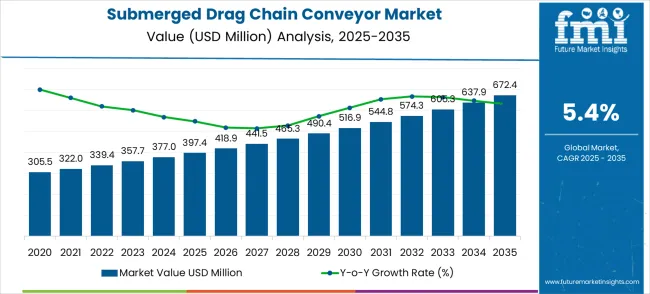
From 2026 to 2030, the market curve starts to accelerate, moving from USD 397.4 million in 2025 to USD 490.4 million by 2030. This growth phase is marked by slightly steeper annual increments, with intermediate values passing through USD 418.9 million in 2026, USD 441.5 million in 2027, and USD 465.3 million in 2028. The market curve shows signs of expansion as industries increasingly adopt automation, improving material handling processes and promoting the growth of submerged drag chain conveyors. The latter half of the curve, from 2031 to 2035, continues with an upward slope, reaching USD 672.4 million, driven by technological innovations, rising industrial output, and an increased need for reliable, efficient conveyor systems.
| Metric | Value |
|---|---|
| Estimated Value in (2025E) | USD 397.4 million |
| Forecast Value in (2035F) | USD 672.4 million |
| Forecast CAGR (2025 to 2035) | 5.4% |
The material handling equipment market is the largest contributor, accounting for approximately 35-40% of the market share. Submerged drag chain conveyors are used for the efficient transportation of bulk materials in industries such as cement, steel, and waste-to-energy, making this parent market essential for driving demand. The waste management and recycling market plays a significant role, contributing around 20-25%, as these conveyors are widely employed in handling ash, slag, and other by-products in waste incineration plants and recycling facilities. The steel manufacturing market accounts for about 15-20%, with submerged drag chain conveyors being used to transport hot and abrasive materials like slag in steel plants, ensuring smooth material flow during production.
The mining and minerals processing market contributes around 10-12%, as these conveyors are utilized in mining operations to transport minerals, ores, and other heavy materials efficiently. The power generation market accounts for approximately 10-12%, as submerged drag chain conveyors are crucial in coal-fired power plants and waste-to-energy facilities for transporting ash and other waste materials.
Market expansion is being supported by the increasing global demand for reliable power generation infrastructure and the corresponding need for robust material handling systems that can operate in high-temperature environments, ensure continuous material transportation, and maintain operational efficiency across various thermal power, waste incineration, and biomass processing applications. Modern power plant operators and industrial facility managers are increasingly focused on implementing conveying solutions that can handle abrasive materials, withstand extreme temperatures, and provide consistent performance in demanding operating conditions. Submerged drag chain conveyors' proven ability to deliver reliable material handling, operate in harsh environments, and support continuous plant operations makes them essential equipment for contemporary power generation and industrial processing facilities.
The growing focus on environmental compliance and operational efficiency is driving demand for submerged drag chain conveyors that can support effective material handling, ensure reliable transportation, and enable comprehensive ecological control. Power generation facilities' preference for material handling systems that combine durability with operational reliability and maintenance efficiency is creating opportunities for innovative submerged drag chain conveyor implementations. The rising influence of renewable energy integration and waste-to-energy technologies is also contributing to increased adoption of submerged drag chain conveyors that can provide reliable material handling without compromising operational efficiency or environmental performance.
The market is segmented by orientation, application, and region. By orientation, the market is divided into horizontal type, inclined type, and others. Based on application, the market is categorized into the thermal power industry, the waste incineration industry, biomass power generation, and others. Regionally, the market is divided into Asia Pacific, North America, Europe, Latin America, and the Middle East & Africa.
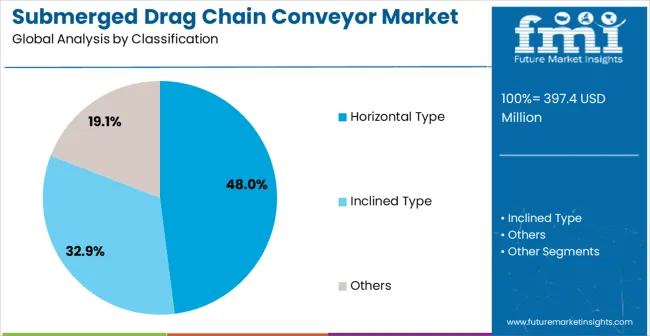
The horizontal type segment is projected to maintain its leading position in the submerged drag chain conveyor market in 2025, capturing 48% of the total market share. This position is reinforced by its role as the preferred configuration for level material transportation and handling in power plants and industrial facilities. Horizontal submerged drag chain conveyors are favored for their easy installation, reliable material flow, and adaptability to different plant layouts. Their proven effectiveness and operational simplicity address the industrial need for efficient material transportation, ensuring consistent performance across diverse power generation and processing applications. As plant operators and maintenance teams continue to invest in these systems, horizontal conveyors remain a cornerstone in material handling strategies.
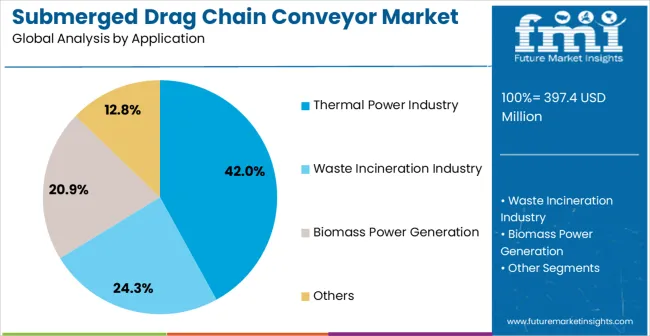
The thermal power industry application segment is expected to represent 42% of the submerged drag chain conveyor market share in 2025. The demand for these conveyors in thermal power plants is driven by their ability to withstand high-temperature environments while maintaining reliable material handling capabilities. Thermal power plants, including coal-fired, gas-fired, and combined-cycle facilities, rely on submerged drag chain conveyors for continuous and efficient material transport. These conveyors not only support plant efficiency but also contribute to meeting environmental compliance standards. As power generation becomes more efficient, and with the increasing focus on regulatory compliance, the thermal power industry will remain a significant driver of market demand for these systems.
The submerged drag chain conveyor market is advancing steadily due to increasing demand for reliable power generation infrastructure and growing adoption of specialized material handling technologies that provide enhanced operational efficiency and environmental compliance across diverse power generation and industrial processing applications. The market faces challenges, including high capital investment costs and installation complexity, maintenance requirements in harsh operating environments, and competition from alternative material handling technologies and conveyor systems. Innovation in automation technologies and remote monitoring systems continues to influence product development and market expansion patterns.
The growing adoption of intelligent automation and remote monitoring technologies is enabling power plant operators to achieve superior operational control, predictive maintenance capabilities, and comprehensive system monitoring for enhanced facility management. Advanced automation systems provide improved operational efficiency while allowing more proactive maintenance scheduling and consistent performance monitoring across various conveyor installations and operating conditions. Manufacturers are increasingly recognizing the competitive advantages of automation integration for operational differentiation and facility optimization.
Modern submerged drag chain conveyor manufacturers are incorporating environmental compliance features and energy integration to enhance operational performance, reduce environmental impact, and support comprehensive facility environmental management through optimized material handling and emission control systems. These technologies improve ecological performance while enabling new applications, including waste-to-energy integration and circular economy implementation. Advanced environmental integration also allows facilities to support comprehensive environmental compliance beyond traditional material handling approaches.
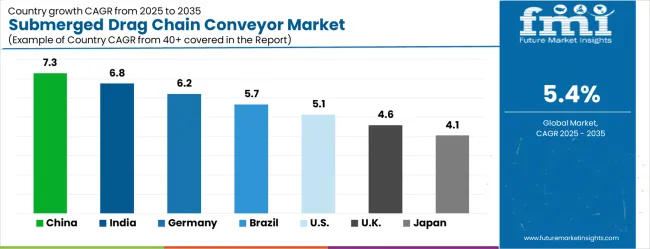
| Country | CAGR (2025-2035) |
|---|---|
| China | 7.3% |
| India | 6.8% |
| Germany | 6.2% |
| Brazil | 5.7% |
| USA | 5.1% |
| UK | 4.6% |
| Japan | 4.1% |
The submerged drag chain conveyor market is experiencing solid growth globally, with China leading at a 7.3% CAGR through 2035, driven by the expanding power generation infrastructure, growing industrial capacity, and significant investment in thermal power plants and waste-to-energy facilities development. India follows at 6.8%, supported by rapid power sector growth, increasing industrial development, and growing adoption of advanced material handling systems in thermal power generation. Germany shows growth at 6.2%, emphasizing advanced engineering and precision conveyor technology development. Brazil records 5.7%, focusing on power infrastructure expansion and industrial modernization initiatives. The USA demonstrates 5.1% growth, supported by established power generation infrastructure and focus on facility modernization. The UK exhibits 4.6% growth, emphasizing power sector efficiency and environmental compliance technologies. Japan shows 4.1% growth, supported by advanced power generation technologies and precision material handling systems.
The report covers an in-depth analysis of 40+ countries withtop-performing countries highlighted below.
India is witnessing steady growth in the submerged drag chain conveyor market, with a projected CAGR of 6.8% from 2025 to 2035. The country’s rapidly expanding industrial base, especially in the steel, cement, and energy sectors, is driving demand for efficient conveyor systems. As India focuses on improving manufacturing infrastructure and increasing its energy production capacity, the need for material handling systems, such as submerged drag chain conveyors, is becoming more prominent. India’s increasing adoption of automation and smart technologies in industrial operations is contributing to the market growth. The growing number of power generation projects and large-scale manufacturing plants across the country is expected to significantly enhance demand.
The submerged drag chain conveyor market in Germany is anticipated to grow at a CAGR of 6.2% from 2025 to 2035. The country’s strong industrial base, particularly in automotive, steel, and cement production, is fueling the demand for advanced material handling systems. Germany’s commitment to maintaining its manufacturing leadership through technological innovation is supporting the need for efficient conveyors that improve production flow and reduce downtime. Germany’s energy sector, particularly in power plants, continues to grow, creating a significant demand for material handling systems in industrial plants. The country is also focusing on incorporating Industry 4.0 solutions, making submerged drag chain conveyors an essential component of the modernization of manufacturing operations.
The submerged drag chain conveyor market in Brazil is expected to grow at a CAGR of 5.7% from 2025 to 2035. As one of the largest industrial economies in South America, Brazil is heavily investing in infrastructure, especially in steel, mining, and power generation. The growth of Brazil’s mining industry, coupled with the demand for efficient material handling systems in its cement and steel sectors, is driving the market. The increasing number of power generation projects, particularly in renewable and thermal power, further boosts the demand for reliable and efficient conveyor systems. Brazil’s push to modernize its industrial capabilities through automation is also contributing to the demand for submerged drag chain conveyors.
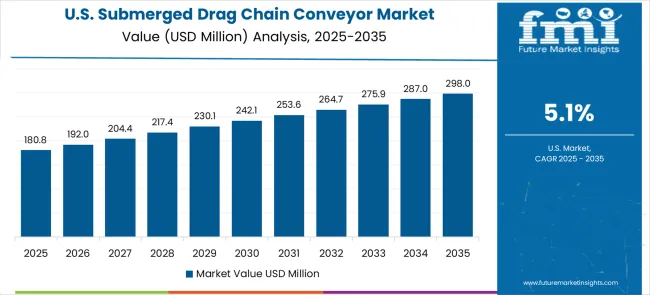
The United States is expected to grow at a CAGR of 5.1% in the submerged drag chain conveyor market from 2025 to 2035. The USA industrial sectors, including steel, cement, and power generation, remain key drivers of demand. With a focus on modernizing infrastructure and expanding energy production, the need for efficient material handling systems is increasing. The United States is also focusing on adopting advanced technologies such as smart sensors, automation, and real-time monitoring systems to improve operational efficiency in industrial settings. The shift toward cleaner energy sources, including nuclear and renewables, is also fueling demand for efficient conveyors in power generation plants.
The United Kingdom’s submerged drag chain conveyor market is projected to grow at a CAGR of 4.6% from 2025 to 2035. The UK’s focus on modernizing its manufacturing sector, particularly in steel production, cement, and automotive industries, is driving the demand for advanced material handling systems. As the country continues to invest in renewable energy and infrastructure projects, the need for efficient conveyors in power plants and large-scale manufacturing facilities is growing.The UK’s commitment to automating industrial operations and enhancing energy efficiency will boost the demand for submerged drag chain conveyors.
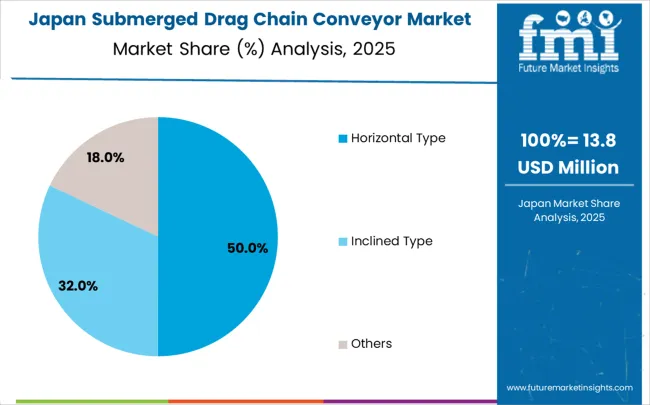
The submerged drag chain conveyor market in Japan is expected to grow at a CAGR of 4.1% from 2025 to 2035. Japan’s industrial sectors, including automotive, steel, and power generation, continue to be major contributors to market growth. With the country’s focus on technological innovation, automation, and energy-efficient manufacturing systems, the demand for advanced material handling solutions is increasing. Japan’s focus on modernizing its power generation plants, particularly in the context of clean energy, further supports the market for submerged drag chain conveyors. The government’s infrastructure investments in both industrial and energy sectors will likely drive continued growth.
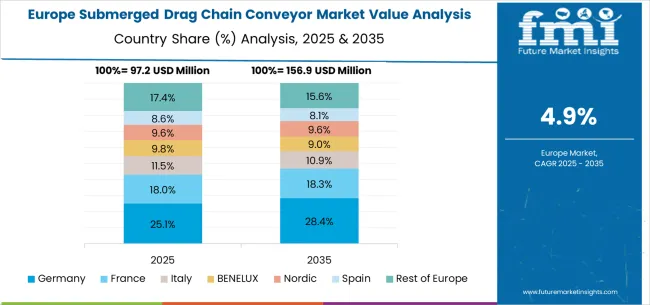
The submerged drag chain conveyor market in Europe is projected to grow from USD 141.9 million in 2025 to USD 229.4 million by 2035, registering a CAGR of 4.9% over the forecast period. Germany is expected to maintain its leadership position with a 27.5% market share in 2025, moderating slightly to 27.3% by 2035, supported by its strong power generation sector, advanced material handling technologies, and comprehensive industrial infrastructure serving major European markets.
The United Kingdom follows with 20.5% in 2025, projected to reach 20.3% by 2035, driven by established power sector efficiency focus, comprehensive environmental compliance framework, and advanced facility modernization programs. France holds 18.0% in 2025, rising to 18.2% by 2035, supported by power generation leadership and growing adoption of advanced material handling technologies. Italy commands 14.0% in 2025, projected to reach 14.1% by 2035, while Spain accounts for 9.0% in 2025, expected to reach 9.1% by 2035. The Netherlands maintains a 4.0% share in 2025, growing to 4.1% by 2035. The Rest of Europe region, including Nordic countries, Eastern Europe, and other markets, is anticipated to maintain its position, holding its collective share at 7.0% by 2035, attributed to increasing power infrastructure modernization and growing advanced material handling adoption across emerging energy markets implementing modern conveyor standards.
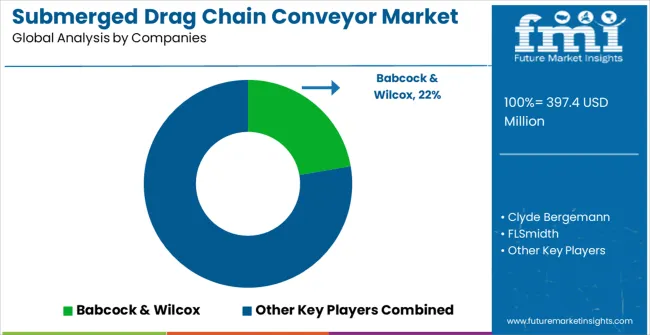
The submerged drag chain conveyor market is characterized by competition among established power generation equipment manufacturers, specialized material handling companies, and integrated industrial solution providers. Companies are investing in advanced conveyor technology research, engineering excellence, durability enhancement, and comprehensive product portfolios to deliver reliable, efficient, and durable submerged drag chain conveyor solutions. Innovation in automation technologies, environmental compliance features, and advanced chain designs is central to strengthening market position and competitive advantage.
Babcock & Wilcox Enterprises, Inc. leads the market with comprehensive power generation solutions, offering advanced submerged drag chain conveyors with a focus on operational reliability and high-temperature performance across diverse power generation applications. Clyde Bergemann provides specialized power plant equipment with an focus on material handling systems and transportation solutions. FLSmidth delivers innovative industrial equipment with a focus on the cement and power industries, with comprehensive material handling capabilities. UCC Environmental specializes in environmental solutions with focus on waste handling and material processing systems. Magaldi Power focuses on specialized conveyor technologies with focus on high-temperature applications and industrial processing. Bevcon Wayors offers comprehensive material handling solutions with a focus on reliability and operational efficiency.
Submerged drag chain conveyors represent a specialized heavy-duty material handling segment within power generation and industrial processing, projected to grow from USD 397.4 million in 2025 to USD 672.4 million by 2035 at a 5.4% CAGR. These robust drag conveyor systems—primarily horizontal configurations for continuous material transport—operate submerged in cooling water to handle hot, abrasive materials like ash and clinker in thermal power plants, waste incineration facilities, and biomass power generation applications. Market expansion is driven by increasing power generation capacity, growing focus on reliable ash handling systems, expanding waste-to-energy infrastructure, and rising demand for environmental compliance solutions in high-temperature industrial environments.
How Energy Sector Regulators Could Strengthen Infrastructure Resilience and Environmental Standards?
How Power Industry Associations Could Advance Technology Standards and Operational Excellence?
How Conveyor System Manufacturers Could Drive Innovation and Competitive Advantage?
How Power Plant Operators Could Optimize Material Handling and Plant Efficiency?
How Industrial Engineering Consultants Could Enable System Optimization?
How Investors and Financial Enablers Could Support Market Growth and Infrastructure Development?
| Items | Values |
|---|---|
| Quantitative Units (2025) | USD 397.4 million |
| Orientation | Horizontal Type, Inclined Type, Others |
| Application | Thermal Power Industry, Waste Incineration Industry, Biomass Power Generation, Others |
| Regions Covered | Asia Pacific, North America, Europe, Latin America, Middle East & Africa |
| Countries Covered | China, India, Germany, Brazil, the United States, the United Kingdom, Japan, and 40+ countries |
| Key Companies Profiled | Babcock & Wilcox Enterprises, Inc., Clyde Bergemann, FLSmidth, UCC Environmental, Magaldi Power, and Bevcon Wayors |
| Additional Attributes | Dollar sales by orientation and application category, regional demand trends, competitive landscape, technological advancements in conveyor systems, automation development, environmental compliance innovation, and operational efficiency optimization |
Asia Pacific
North America
Europe
Latin America
Middle East & Africa
The global submerged drag chain conveyor market is estimated to be valued at USD 397.4 million in 2025.
The market size for the submerged drag chain conveyor market is projected to reach USD 672.4 million by 2035.
The submerged drag chain conveyor market is expected to grow at a 5.4% CAGR between 2025 and 2035.
The key product types in submerged drag chain conveyor market are horizontal type, inclined type and others.
In terms of application, thermal power industry segment to command 42.0% share in the submerged drag chain conveyor market in 2025.






Our Research Products

The "Full Research Suite" delivers actionable market intel, deep dives on markets or technologies, so clients act faster, cut risk, and unlock growth.

The Leaderboard benchmarks and ranks top vendors, classifying them as Established Leaders, Leading Challengers, or Disruptors & Challengers.

Locates where complements amplify value and substitutes erode it, forecasting net impact by horizon

We deliver granular, decision-grade intel: market sizing, 5-year forecasts, pricing, adoption, usage, revenue, and operational KPIs—plus competitor tracking, regulation, and value chains—across 60 countries broadly.

Spot the shifts before they hit your P&L. We track inflection points, adoption curves, pricing moves, and ecosystem plays to show where demand is heading, why it is changing, and what to do next across high-growth markets and disruptive tech

Real-time reads of user behavior. We track shifting priorities, perceptions of today’s and next-gen services, and provider experience, then pace how fast tech moves from trial to adoption, blending buyer, consumer, and channel inputs with social signals (#WhySwitch, #UX).

Partner with our analyst team to build a custom report designed around your business priorities. From analysing market trends to assessing competitors or crafting bespoke datasets, we tailor insights to your needs.
Supplier Intelligence
Discovery & Profiling
Capacity & Footprint
Performance & Risk
Compliance & Governance
Commercial Readiness
Who Supplies Whom
Scorecards & Shortlists
Playbooks & Docs
Category Intelligence
Definition & Scope
Demand & Use Cases
Cost Drivers
Market Structure
Supply Chain Map
Trade & Policy
Operating Norms
Deliverables
Buyer Intelligence
Account Basics
Spend & Scope
Procurement Model
Vendor Requirements
Terms & Policies
Entry Strategy
Pain Points & Triggers
Outputs
Pricing Analysis
Benchmarks
Trends
Should-Cost
Indexation
Landed Cost
Commercial Terms
Deliverables
Brand Analysis
Positioning & Value Prop
Share & Presence
Customer Evidence
Go-to-Market
Digital & Reputation
Compliance & Trust
KPIs & Gaps
Outputs
Full Research Suite comprises of:
Market outlook & trends analysis
Interviews & case studies
Strategic recommendations
Vendor profiles & capabilities analysis
5-year forecasts
8 regions and 60+ country-level data splits
Market segment data splits
12 months of continuous data updates
DELIVERED AS:
PDF EXCEL ONLINE
Submerged Chain Conveyor Market Size and Share Forecast Outlook 2025 to 2035
Chain Conveyors Market Size and Share Forecast Outlook 2025 to 2035
Conveyor Belt Tracking Devices Market Size and Share Forecast Outlook 2025 to 2035
Conveyor Belt Market Size and Share Forecast Outlook 2025 to 2035
Drag Reducing Agent Market Size and Share Forecast Outlook 2025 to 2035
Conveyor System Market Size and Share Forecast Outlook 2025 to 2035
Conveyor Drives Market Analysis - Size, Share, and Forecast Outlook 2025 to 2035
Submerged ARC Furnaces Market Size and Share Forecast Outlook 2025 to 2035
Conveyor Dishwasher Market Size and Share Forecast Outlook 2025 to 2035
Conveyor Maintenance Industry Analysis in Australia - Size, Share, and Forecast Outlook 2025 to 2035
Conveyor Dryer Market Growth, Trends & Forecast 2025 to 2035
Conveyors and Belt Loaders Market Growth - Trends & Forecast 2025 to 2035
Conveyor Ovens & Impinger Ovens Market
Conveyor Belt Materials Market
UV Conveyor Systems Market
Cold Chain Logistics Transport Insulated Truck Market Size and Share Forecast Outlook 2025 to 2035
Blockchain Interoperability Market Size and Share Forecast Outlook 2025 to 2035
Blockchain Food Traceability Market Size and Share Forecast Outlook 2025 to 2035
Cold Chain Packaging Market Size and Share Forecast Outlook 2025 to 2035
Cold-Chain Sensor Encapsulators Market Analysis - Size and Share Forecast Outlook 2025 to 2035

Thank you!
You will receive an email from our Business Development Manager. Please be sure to check your SPAM/JUNK folder too.
Chat With
MaRIA